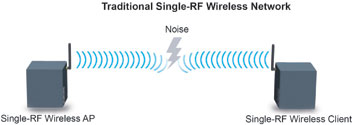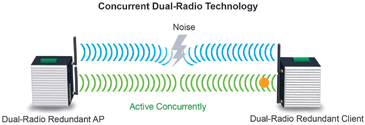
The unpredictability of radio interference has long been a deterring factor for industrial operators wanting to deploy wireless connectivity for mission-critical applications. Many self-healing and dual-band technologies have been developed to mitigate the impact of interference. However, signal recovery and renegotiation can still result in packet loss and is unacceptable for latency intolerant applications. This paper will discuss how zero packet loss communication can be achieved, using concurrent dual-radio transmission, to provide highly reliable wireless connectivity for safety critical applications, with benefits such as optimised data throughput, interference immunity and latency free transmissions.
Overview
Conventional wireless networks typically provide a best effort level of service and are susceptible to environmental interference, which can cause excessive packet loss and result in repeated resend requests, rendering them unacceptable for many latency sensitive applications. Self-healing wireless technologies have been introduced to provide communication recovery through channel/band switchovers. However, recovery can take many seconds, if not minutes, to complete. Even when routine measures are taken to identify and eliminate environmental interference, wireless interference still remains a possibility and can compromise network reliability and system safety.
Traditional dual-band access points can be misleading in regards to the way they actually operate. Many users expect the access points to transmit data on both bands simultaneously, only to discover that the access points transmit via one band and switches to the other band if transmission quality drops below a certain threshold. This type of redundancy has its limitations:
* Switching over to the other band takes time and packet loss will occur during this transition period.
* If the threshold for band switchover is set too low, data rate will need to drop below the threshold before the current link is disconnected. This is unacceptable for applications that require a continuous and high level of performance.
* If the threshold is set to trigger the band switch over at a higher rate, a ‘ping-pong’ effect – where the wireless connection constantly switches back and forth between the two bands – becomes a potential problem, making the switching mechanism very inefficient.
Facts about wireless interference
Interference can be difficult to detect and quantify: When interference distorts a packet sent by the transmitter, an acknowledgement packet will not be sent by the receiving end and the packet will have to be resent. Also, the 802.11 protocol is designed to delay transmission if existing interference is detected and will transmit packets only after the interference has cleared. Prolonged interference can severely reduce the throughput of the wireless network.
Non-WiFi devices can also cause interference: Cordless telephones, wireless cameras, Bluetooth/ZigBee devices and microwave ovens are just a few examples of products which can severely impact the quality of wireless networks. Even a poorly wired electrical circuit can cause interference. In addition to a reduction in data throughput, interference can trigger data rate renegotiation, or back-off, lowering data transmission rates unnecessarily.
Increasing the density of access points will not reduce interference: A higher density of access points will actually generate more interference on the network. Reducing the transmission power of each access point will reduce co-channel interference, but effectively negates the initial effort of increasing the access point density.
There are possibly new and hidden sources of interference: The obvious benefits of wireless connectivity has spurred device manufacturers to offer new wireless products, such as surveillance cameras, media players, motion sensors and other personal electronic devices. Even defective electrical circuits within the walls can cause interference.
Concurrent dual-radio technology
Many advanced wireless technologies are available to detect interference, provide source location and automatically switch bands/channels to restore wireless communications. However, interference immunity/prevention is invariably preferable to interference mitigation and is the only way to ensure uninterrupted communication for safety critical applications.
Concurrent dual-radio transmission virtually eliminates the possibility of wireless interference. The concept of concurrent dual-radio technology is simple: for every outbound packet, send a duplicate packet simultaneously via the secondary frequency to ensure that at least one of the packets reaches the receiver. Latency sensitive applications can be deployed across a concurrent dual-radio wireless network because the chance that an unintentional source of interference can simultaneously disrupt both bands (2,4 and 5 GHz) is highly unlikely (see figures).


Safety-critical and real-time wireless applications
Wireless video monitoring systems for safety-critical applications can require megabit speeds. Interference can result in frame skips, screen freeze and dropouts. For other wireless safety-critical applications with zero latency tolerance, such as control systems at cable car stations and automated guided vehicles (AGV) in factory automation, concurrent dual-radio transmission with interference immunity is what operators need to ensure real-time performance with zero data loss communication.
Certified for SafetyNET p by Safety Network International e.V., Moxa’s wireless access points provide proven redundant wireless link technology for real-time Ethernet connectivity. The AWK-5222 and AWK-6222 series industrial wireless AP/bridge/client devices feature two independent RF modules. This means that both modules can be transmitting simultaneously, duplicating data transmissions and eliminating the possibility of packet loss during band switch over. Requests to resend packets are significantly reduced because transmitting simultaneously over two distinct bands ensures a high probability that at least one of the identical packets will reach the client/receiver.
Simultaneous dual-radio transmissions also increase the throughput by reducing the number of resend requests. Throughput is the average rate with which actual usable data is delivered over a path. It is possible to have high data rate yet unsatisfactory throughput if a large portion of the bandwidth is consumed by packet retransmission.
| Tel: | +27 11 781 0777 |
| Email: | info@rjconnect.co.za |
| www: | www.rjconnect.co.za |
| Articles: | More information and articles about RJ Connect |

© Technews Publishing (Pty) Ltd | All Rights Reserved